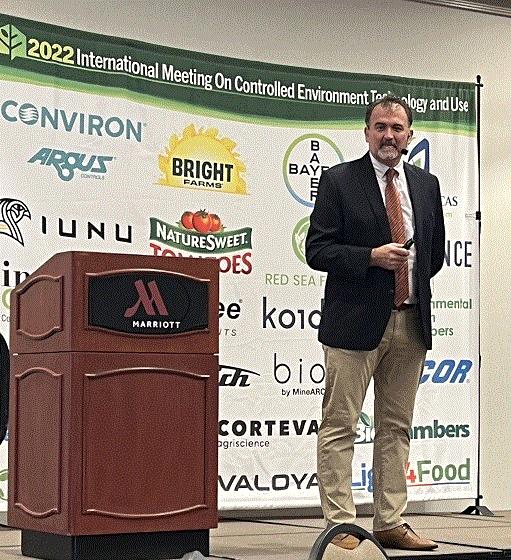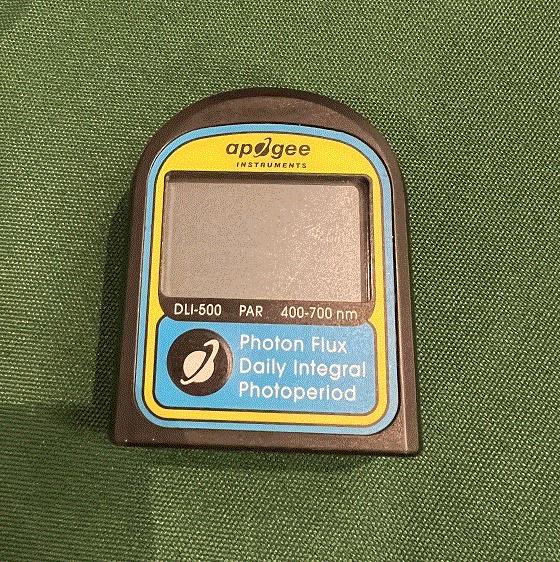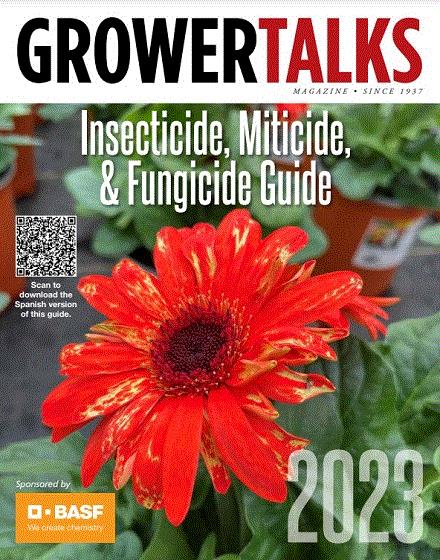More CEA Transparency?
This month, I attended an international meeting of controlled environment ag researchers, vendors, consultants and growers in Tucson, Arizona, and came back with some key takeaways for the industry. The meeting was organized by the North Central Extension and Research Activity-101 (or NCERA-101), a committee that helps plant scientists understand how to use CEA effectively. This international meeting was supposed to take place in March 2020, but of course we all know what happened then.

Murat Kacira, executive director of the Controlled Environment Agriculture Center (CEAC) at University of Arizona, welcomes 205 attendees from 12 countries.
First off, kudos to the students and faculty at University of Arizona’s CEAC for making the event happen. It was a fascinating three days of meetings and tours, and while I’ll be talking about some of the exciting research I heard at the meeting more in the coming weeks, I wanted to highlight a few areas that really stood out:
-
There were requests for more transparency from growers to help forward the research that will be necessary to increase efficiencies. Right now, researchers rely heavily on modeling, which doesn’t allow them to use real-world numbers in their studies. Much of the opaqueness comes from the highly competitive nature of getting venture capital funding that can be worth millions of dollars, one grower said, so the challenge is finding ways to work around that competitiveness.
-
Along with more transparency, speakers also called for more standardization of measurements, which would allow better comparisons and for the industry as a whole to see what are the typical standards and what are cutting edge. If and when the industry is regulated, it would behoove growers to be regulated based on the standard operation and not cutting edge.
-
Better breeding to produce crops specifically for commercial CEA can make an impact on improving efficiencies, and both growers and researchers noted they would like to see more done in this area.
-
Though lighting research is vitally important to crop timing, flavor and nutrition and creating efficiencies, there are lots of other areas where research can be (and is being) done. After hearing Nadia Sabeh ("Dr. Greenhouse") talk about HVAC systems, it seems like this is an area that has a lot of opportunity for improvement, particularly as she describes the systems being a major part of the energy costs of an operation. And, she noted, the average system experiences 25% leakage.
As I said, over the next several weeks I’ll dive into more of the research talked about at the event, including some of the efforts to learn about CEA by growing in space (there’s some really cool stuff happening in this realm). Stay tuned! In the meantime, if you have thoughts about transparency in the industry, email me at jpolanz@ballpublishing.com.

New DLI Meters
I found a couple of news products at the NCERA-101 meeting and I’m going to share one this week and another in my next send.
I talked with the folks at Apogee Instruments, which recently introduced a new series of meters to measure PAR, daily light integral (DLI) and photoperiod. These small devices can be used for spot-checking PAR or ePAR levels, and they automatically record DLI and photoperiod for up to 99 days.

The models are:
DLI-400: lowest-cost option and it measures 400-700 nm only in sunlight and under some broadband light sources.
DLI-500: Full spectrum, accurate for measuring 400-700 nm under all light sources, including LEDs.
DLI-600: ePAR is accurate for measuring the newly discovered extended PAR (ePAR) 400-750 nm range under all light sources.
They also noted they will have a greenhouse weather station coming out later this year to measure light, temperature, humidity, CO2 and more.
Aris Adds More Herbs With Silverleaf Agreement
I always like to report on industry activity in Northeast Ohio, where I call home, and now I get a chance to do that very thing: Barberton, Ohio-based Aris Horticulture recently announced an agreement with Silverleaf Greenhouses for Aris’ Green Leaf Plants Division take on Silverleaf’s extensive herb business of more than 200 varieties for 2023. Silverleaf, located near Walden, New York, sold its facilities to a recreational cannabis operator.

According to the announcement, Silverleaf Owner Larry Silverman will provide transition consulting. “I am looking forward to working with the Aris Green Leaf team to provide transitional assistance and future support for the continued supply of high-quality herbs to my customers.”
The addition of Silverleaf’s line includes split 102s (51 cell), 2.5-in. and custom 4-in., which were expected to be added to Green Leaf’s offerings by the end of the month. Because of the short transfer lead time, two Silverleaf programs, scented geraniums and mixed herb trays in three 17-strips will be suspended for 2023.
All the new orders will be produced at the Green Leaf Plants facility in Lancaster, Pennsylvania (Aris Horticulture headquarters are in Barberton).
If you have questions, you can contact Larry Silverman, larry@silverleafgreenhouses.com, Blair Hoey at Green Leaf Plants, blair.hoey@glplants.com or Dave Ogle, director of sales at Aris, dave.ogle@arishort.com.

Climate-Proof Crops
Remember those efficiencies I talked about at the top, particularly as they relate to breeding? It’s vital to understand how plants respond to a variety of conditions if you’re growing indoors. To do that, more phenotyping research is necessary. That’s why Wageningen University & Research in the Netherlands created the Netherlands Plant Eco-phenotyping Centre (NPEC). Lighting company Fluence recently announced it would be the LED technology partner for the venture.
Fluence’s VYPR DUO 3x2 fixtures are in the specialized, state-of-the-art phenotyping greenhouse, which has five climate-controlled compartments featuring 3-D and hyperspectral imaging, conveyor systems and sensors to produce high-precision measurements that include plant size, color and leaf positioning, according to the announcement. Researchers can examine plants to better understand their genetic response to conditions like heat, drought or increased soil salinification.
“Establishing research on genotype-phenotype associations, specifically how ecological and environmental variables impact the plant phenotype, is essential for the development of novel, climate-proof crops,” says Rick van de Zeede, senior scientist and project manager for NPEC. “Automated phenotyping will also allow for a dramatic increase in the speed of plant breeding and time to market for novel crop varieties.”
The official opening of NPEC will be after the International Plant Phenotyping Symposium 2022, happening through Friday.

IMF Guide Out Now
The 2023 GrowerTalks Insecticide, Miticide & Fungicide Guide, sponsored by BASF, is now available.
The new IMF Guide contains the most up-to-date lists of fungicides organized by FRAC, and insecticides and miticides organized by target pests. The insecticide and miticide list was compiled by Raymond Cloyd of Kansas State University. And don’t miss the list of herbicides commonly used in nurseries, compiled by Chris Marble of the University of Florida. It's available at the end of the guide.
You’ll also find articles from Suzanne Wainwright on how to use beneficial nematodes for pest management. Plus, read up on rotation programs for major diseases and pests.

But wait—that’s not all! The IMG Guide is now available in both English and Spanish! Kudos to both GrowerTalks and BASF for making this useful annual publication accessible to Spanish-speaking team members.
English version
Spanish version




As always, feel free to email me at jpolanz@ballpublishing.com with comments, questions, news and views.
Until next time, stay safe and be healthy,

Jennifer Polanz
Editor-at-Large
Inside Grower
This email received by 29,004 loyal readers!
Interested in advertising in Inside Grower? Contact Paul Black or Kim Brown and they'll show you how easy, effective and affordable it is.